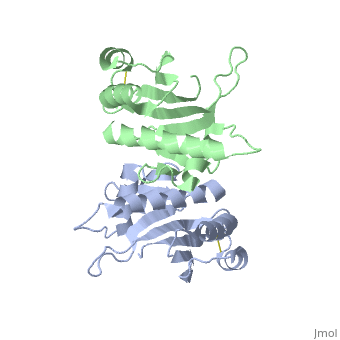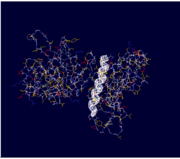Pilin
From Proteopedia
(Difference between revisions)
| Line 18: | Line 18: | ||
==Function== | ==Function== | ||
| - | Type IV pili are diverse in function; they mediate numerous cellular functions via their polymeric machinery. These functions include cell adhesion, signalling, phage attachment, surface motility, biofilm formation and DNA uptake by natural transformation. Specifically, the type IVb pilus of ''Salmonella typhi'' is the adhesion factor that allows the pathogen to enter into the gastrointestinal cells of humans with ease. The first step in ''S.typhi'' pathogenesis is the type IVb pilus self-mediated self-association in the anerobic human small intestine preceding the entry into the human intestine epithelium. <ref name=journal1>PMID:19626704</ref> | + | '''Type IV pili''' are diverse in function; they mediate numerous cellular functions via their polymeric machinery. These functions include cell adhesion, signalling, phage attachment, surface motility, biofilm formation and DNA uptake by natural transformation. Specifically, the type IVb pilus of ''Salmonella typhi'' is the adhesion factor that allows the pathogen to enter into the gastrointestinal cells of humans with ease. The first step in ''S.typhi'' pathogenesis is the type IVb pilus self-mediated self-association in the anerobic human small intestine preceding the entry into the human intestine epithelium. <ref name=journal1>PMID:19626704</ref> |
A proposed prerequisite for CFTR binding is the dimer formed in the symmetrical subunit of PilS. <ref name=journal2>Asha M. Balakrishna,Yvonne Yih-Wan Tan, Henry Yu-Keung Mok,Anand M. Saxena,and Kunchithapadam Swaminathan.Crystallization and preliminary X-ray diffraction analysis of Salmonella typhi PilS. 2006 October 1; 62(Pt 10): 1024–1026</ref> The type IVb PilS protein binds to a 15-mer peptide that corresponds to the first extracellular domain of the human cystic fibrosis transmembrane regulator (an epithelial chloride channel) in the INT407 cell membrane. PilS contains a binding pocket in the region where the CFTR peptide is attached to the protein. <ref name=journal1>PMID:19626704</ref> The surface around this active site pocket is slightly positively charged because of the presence of Lys75, Lys120, and Arg 169. This means it is able to effectively bind the negatively charged CFTR peptide. Residues 113-117 of CFTR are crucial for the S. typhi pilus binding and Glu115 and Glu116 of the peptide are involved in binding to the PilS protein.<ref name=journal1>PMID:19626704</ref> | A proposed prerequisite for CFTR binding is the dimer formed in the symmetrical subunit of PilS. <ref name=journal2>Asha M. Balakrishna,Yvonne Yih-Wan Tan, Henry Yu-Keung Mok,Anand M. Saxena,and Kunchithapadam Swaminathan.Crystallization and preliminary X-ray diffraction analysis of Salmonella typhi PilS. 2006 October 1; 62(Pt 10): 1024–1026</ref> The type IVb PilS protein binds to a 15-mer peptide that corresponds to the first extracellular domain of the human cystic fibrosis transmembrane regulator (an epithelial chloride channel) in the INT407 cell membrane. PilS contains a binding pocket in the region where the CFTR peptide is attached to the protein. <ref name=journal1>PMID:19626704</ref> The surface around this active site pocket is slightly positively charged because of the presence of Lys75, Lys120, and Arg 169. This means it is able to effectively bind the negatively charged CFTR peptide. Residues 113-117 of CFTR are crucial for the S. typhi pilus binding and Glu115 and Glu116 of the peptide are involved in binding to the PilS protein.<ref name=journal1>PMID:19626704</ref> | ||
PilS causes typhoid by entering the enterocytes and specialized M cells of the small intestine. After entry, it is transferred to the intestinal submucosa and is taken up by host macrophages. The overall mechanism of the entry into the enterocytes is complicated and involves intercellular adhesins and intracellular signaling which change the host cell's vacuolar and cytoskeletal organization. <ref name=journal1>PMID:19626704</ref> | PilS causes typhoid by entering the enterocytes and specialized M cells of the small intestine. After entry, it is transferred to the intestinal submucosa and is taken up by host macrophages. The overall mechanism of the entry into the enterocytes is complicated and involves intercellular adhesins and intracellular signaling which change the host cell's vacuolar and cytoskeletal organization. <ref name=journal1>PMID:19626704</ref> | ||
| + | |||
| + | == 3D Structures of pilin == | ||
| + | [[Pilin 3D structures]] | ||
| + | |||
</StructureSection> | </StructureSection> | ||
== 3D Structures of pilin == | == 3D Structures of pilin == | ||
| Line 39: | Line 43: | ||
**[[2py0]] - PaPIL PAK (mutant) <BR /> | **[[2py0]] - PaPIL PAK (mutant) <BR /> | ||
**[[1pan]], [[1pao]] - PaPIL PAO – NMR<BR /> | **[[1pan]], [[1pao]] - PaPIL PAO – NMR<BR /> | ||
| - | **[[1hpw]], [[1qve]], [[1rg0]] – PaPIL residues 29-150<BR /> | + | **[[1hpw]], [[1qve]], [[1rg0]], [[6bbk]] – PaPIL type I residues 29-150<BR /> |
**[[1ay2]], [[2pil]], [[2hi2]], [[2hil]] – NgPIL type IV – ''Neisseria gonorrhoeae''<BR /> | **[[1ay2]], [[2pil]], [[2hi2]], [[2hil]] – NgPIL type IV – ''Neisseria gonorrhoeae''<BR /> | ||
**[[5vxx]] - NgPIL type IV – Cryo EM<br /> | **[[5vxx]] - NgPIL type IV – Cryo EM<br /> | ||
| Line 66: | Line 70: | ||
**[[4ixj]] - PIL type IV – ''Clostridium difficile''<br /> | **[[4ixj]] - PIL type IV – ''Clostridium difficile''<br /> | ||
**[[3sok]] - PIL – ''Dichelobacter nodosus''<br /> | **[[3sok]] - PIL – ''Dichelobacter nodosus''<br /> | ||
| + | **[[6jbv]] - LrPIL – ''Lactobacillus rhamnosus''<br /> | ||
**[[4s3l]] - PIL type II – ''Streptococcus pneumoniae''<br /> | **[[4s3l]] - PIL type II – ''Streptococcus pneumoniae''<br /> | ||
**[[5z24]] - PIL (mutant) – ''Lactobacillus rhamnosus''<br /> | **[[5z24]] - PIL (mutant) – ''Lactobacillus rhamnosus''<br /> | ||
**[[5lp9]] - PIL – ''Shigella flexneri''<br /> | **[[5lp9]] - PIL – ''Shigella flexneri''<br /> | ||
| + | **[[6i20]] – PIL1 – ''Streprococcus sanguinis'' - NMR<br /> | ||
*Pilin binary complex | *Pilin binary complex | ||
Revision as of 08:36, 24 November 2019
| |||||||||||
3D Structures of pilin
Updated on 24-November-2019
Additional Resources
To See additional information, see: Bacterial Infections
References
- ↑ 1.00 1.01 1.02 1.03 1.04 1.05 1.06 1.07 1.08 1.09 1.10 Balakrishna AM, Saxena AM, Mok HY, Swaminathan K. Structural basis of typhoid: Salmonella typhi type IVb pilin (PilS) and cystic fibrosis transmembrane conductance regulator interaction. Proteins. 2009 Nov 1;77(2):253-61. PMID:19626704 doi:10.1002/prot.22500
- ↑ 2.0 2.1 2.2 Asha M. Balakrishna,Yvonne Yih-Wan Tan, Henry Yu-Keung Mok,Anand M. Saxena,and Kunchithapadam Swaminathan. Crystallization and preliminary X-ray diffraction analysis of Salmonella typhi PilS. 2006 October 1; 62(Pt 10): 1024–1026
Proteopedia Page Contributors and Editors (what is this?)
Michal Harel, Elyse Yaremco, David Canner, Andrea Gorrell, Alexander Berchansky


